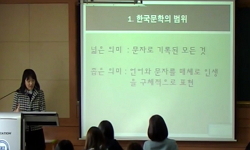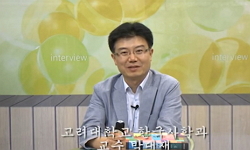Ilyeon(一然, 1206-1289) understood that the destructions of national pride and original culture by many foreign invaders was a national crisis in the times of King Chungyeol(忠烈王), and tried to find a breakthrough by the divine protection of Bu...
http://chineseinput.net/에서 pinyin(병음)방식으로 중국어를 변환할 수 있습니다.
변환된 중국어를 복사하여 사용하시면 됩니다.
- 中文 을 입력하시려면 zhongwen을 입력하시고 space를누르시면됩니다.
- 北京 을 입력하시려면 beijing을 입력하시고 space를 누르시면 됩니다.
https://www.riss.kr/link?id=T8586823
- 저자
-
발행사항
대전 : 충남대학교 대학원, 2002
-
학위논문사항
학위논문(박사)-- 충남대학교 대학원: 국어국문학과 고전문학전공 2002. 2
-
발행연도
2002
-
작성언어
한국어
- 주제어
-
KDC
811.1 판사항(4)
-
DDC
895.7 판사항(20)
-
발행국(도시)
대전
-
형태사항
ii, 191 p. : 삽도 ; 26 cm .
-
일반주기명
지도교수: 金善祺
참고문헌: p. 181-186 - 소장기관
-
0
상세조회 -
0
다운로드
부가정보
다국어 초록 (Multilingual Abstract)
Ilyeon(一然, 1206-1289) understood that the destructions of national pride and original culture by many foreign invaders was a national crisis in the times of King Chungyeol(忠烈王), and tried to find a breakthrough by the divine protection of Buddha and a search for culture. Ilyeon's 『Samgungnyusa』is a part of those works, and he advocated pride that Korean history and culture are equal to Chinese ones through the book. Therefore, we can find Korean self-reliance in every context of『Samgungnyusa』First of all, there is a record of the establishment of Joseon(朝鮮) by Tangunwanggeom(檀君王儉) in preface of 「Gii(紀異)」It seems to be from a national independent spirit that Korea is equal to China since there is 50 year time difference from Emperor Yo(堯) in China. It is also revealed in that King Hyeokgeose(赫居世王), King Namhae(南解王), King Norye(弩禮王) are called three emperors. Second, the word 'emperor(天子)', which appears in Chinese historical and a letter 'Bung(崩)', which is used to describe only his death, are used in 『Samgungnyusa』without any hesitation unlike in other records. It also shows that our Korean history is an independent national history, directly connected to Heaven, rather than a subjective and additional history to China. It means that the Korean sovereign holds the same position as Chinese emperor as well. Third, the comparison with China in each item tells us lots of things. We can find it in「Gii」, and others largely;「Gii」manifests that Korean is a cultural and historical people, starting from records that the marvelous births and the miracles of the founders of three kingdoms as well as Tangunwanggeom to beauty of Silla(新羅). Meanwhile, other records tell religious superiority and national predominance widely by taking introduction of Buddhism in Korea at the same time as in China, pride as a Buddhist land, construction of towers and Buddhist statues, sarira enshrinement, a story of divine respondence, appearance of a learned and virtuous hermit and a wonder monk, and the sharp difference in trifling animals repaying human kindness. They are dividing miracles of public and those of Buddhism to verify this respect. The superiority of Hyangga is compared with that of Chinese poems, and it manifest a firm faith on excellence of Korean ones.
The independent spirit of『Samgungnyusa』reveals in its arrangement. That is, 『Samgungnyusa』is arranged according to Wangryeok(王曆), Gii(59), Heungbeop(興法, 7), Tapsang(塔像, 30), Euhae(義解, 14), Sinju(神呪, 3), Gamtong(感通, 10), Pieun(避隱, 10), Hyoseon(孝善, 5), and they seem to be systematic at a glance. However, out of total 138 items there are 59 items in「Gii」while 79 items in others. In addition,「Gii」, is arranged according to the times focussing on kings and the country, while others are according to the theme of the story focussing on a learned and virtuous priest or an ordinary man. This kind of classification suggests that『Samgungnyusa』is not just a compilation for admiring a specific religion simply.
From this reason, the Hyangga of『Samgungnyusa』 have such characteristics and functions, It can be verified concretely from their background and relations. <Mojukjirangga(慕竹旨郞歌)> belongs to 'Jukjirang in the times of King Hyoso(孝昭王代 竹旨郞)> In relation to this, <Mojukjirangga> functions to glorify Hwarang(花郞) Jukjirang. <Mojukjirangga> intends to announce that there is a highly talented person of better integrity than any other Chinese general and to let descendants know it. <Hunhwaga(獻花歌)> is recorded in 'Surobuin(水路夫人)? However, it has little to do with kings. After all, the reason why it is recorded in「Gii」is from high praise for Silla beauty. The ending record that 'she was often caught by divine creatures, whenever she walked in deep mountain or around lake, since none is more beautiful than Surobuin in the world' verifies it. Therefore, <Hunhwaga> can be called Haeoga (解悟歌) to prevent a divine creature from tempting and abducting Suro(水路) in advance. It is also to express equality of beauty through Surobuin symbolizing the Silla beauty. <Anminga(安民歌)> is recorded in 'Pyohundaedeok Chungdamsa in the times of King Gyeongdeok(景德王 忠談師 表訓大德)', <Chankiparangga(讚耆婆郞歌)> is included. <Anminga> is closely related to king like Wolmyeongsa(月明師)�s <Dosolga(도솔가)>. Both of songs have common characteristics in that they are closely related to circutnstances in the times of King Gyeongdeok. Therefore, <Anminga> is a 'song for ruling a country and making people comfortable' It has two meanings: there were persons like Chungdamsa who was a highly talented song composer and Pyohundaedeok who could be presented to god freely, and it is for preventing unreasonable reinforcement of sovereignty and inconsiderate succession of a legitimate son. In this respect <Chankiparangga> is the same in that. That is, it was used as an instrument to exemplify Chungdamsa's ability of composing folk songs when a person like Kiparang(耆婆郞) was demanding desperately. Therefore, <Chankiparangga(讚耆婆郞歌)> should be seen as a song for admiring Kiparang literally. <Cheoyongga(處容歌)> is included in 'Cheoyongrang Mangbaesa(處容歌 望海寺)'. It means that <Cheoyongga> should be understood in the whole context of circumstances in the times of King Heongang(憲康王). In spite of continuous revelation of divine protection, King Heongang and his people indulged themselves in seeking pleasure continuously, and finally a disease spirit outraged Cheoyong(處容)'s wife by irritating him. Cheoyong was so generous to forgive the spirit, and it shows that one cannot lose his home and country if he comes back his own duty. Therefore, it is reasonable to see <Cheoyongga> as a song for understanding in the process of king and his people bringing a national ruin upon themselves. It also gives us a severe warning that a country can be fallen if king and his people can't preserve it, even in a peaceful reign when a dragon is protecting. <Seodongyo(署童謠)> is included in the record of 'King Mu(武王)'. In its relation to the item, <Seodongyo> is a strategic song for Seodong(署童) to get Seonhwagongju(善花公主). For this, Seodong took double actions; for children, the song should be easy to be. sung, and therefore it could be delivered easily, It also should be easy for government officials to understand its meaning and to be deceived perfectly at the same time. Therefore, <Seodongyo> is a strategic wishful song containing one's sincere hope of accomplishing his one aim. It shows a process for a hero to ascend the throne. It expresses historical equality of Korea to China. <Dochunsudaebiga(禱天手大悲歌) is handed down in 'Bunhwangsa chunsudaebi Maengadeukan(芬皇寺 千手大悲 盲兒得眼)'. We can discover that it is a song for Chunsudaebi's respondence of great compassion and great mercy rather than that for child, since it is recorded in「Tapsang」. The fact that Chunsudaebi who granted a five-year-old boy*s wish suggests that Korea is .a real Buddhist land. This manifests that Buddhist power is sublimated in a spiritual support to fight with foreign invaders. In this context, <Dochunsudaebiga> is a praying song for Chunsudaebi of peat compassion and great mercy to give a ray of hope to a child. <Wonwangsangga(願往生歌)y is handed down in 'Gwanddeok Eomjang(廣德 嚴壯)'. However, the subject of this item is not Gwanddeok who became a highly estimated monk after seeking the truth with all his might, but Eomjang who was lazy in seeking the truth and even bed to outrage Gwanddeok's wife. Therefore, <Wonwangsangga> is a Buddhist invocation song to reveal strong Buddhist mind of becoming a highly estimated monk. The characteristics of this song is a warning that one can't be a highly estimated monk unless he does his best for the practice of Buddhistic austerities. The background of <Jemangmaega (祭亡妹歌)> is briefly referred to in explaining the background of <Dosolga> and Wolmyeongsa's miraculous achievements. It has an elegiac characteristic in that it was composed on his sister's deathbed. This song also tells Wolmyeongsa's talent to compose old Korean folk songs and reveals virtue of <Jemangmaega>, <Hyeseongga (彗星歌)> is handed down in the record of 'Yungcheonsa Hyeseongga Times of King Jinpyeong(眞平王代 融天師 彗星歌)'. The fact that a comet attacked Simdaeseong(心大星) means it attacks the center of Silla, that is, Geongiu(慶州). Therefore, it symbolizes Japanese soldiers' invasion to Geongiu of Silla. However, Yungcheonsa poses a strong question how trifling Japanese dare to invade this land of Buddhist's, and refuses it false. In this respect, 'Yungcheonsa Hyeseongga Times of Sing Jinpyeong' and <Hyeseongga> show pride in sacred and miraculous Buddhist land. It call be said that <Hyeseongga> is a song of national salvation. <Wongga(怨歌)> is recorded in 'Sinchung gwaegwan(信忠掛冠)'. It seems that <Wongga> was composed becasue II Yeon was interested in the fact that Sinchung had invoked a blessing before the portraits of Kings after throwing away his position and constructing Dansoksa(斷俗寺). Therefore, there is a very strong possibility that <Wonggay> shows that Sinchung was a faithful servant of King. <Wongga> has the function of loyalist song in this sense. <Ujeokga(遇賊歌)y is included in 'Yeongjae Ujeok(永材遇賊)', The examination of 'Yeongjae Ujeok' is not unrelated to compilation intention of「Pieun」. In this context, 'Yeongjae's love for people soaked in 'Yeongjae Ujeok' and <Ujeokga>, <Ujeokga> has the characteristic and function of a love song for people. As we examined above, Ilyeon arranged the items of Hyangga in『Samgungnyusa』according to their characteristics as he intended to. Therefore, The background and relation should be considered for correct understanding of them. Only that time, we can understand that Ilyeon tried to elucidate historical equality of Korea to that of China and national independent spirit through『Samgungnyusa』.
목차 (Table of Contents)
- 목차
- I. 서론 = 1
- 1. 연구 목적 및 연구사 = 1
- 2. 연구방법 = 5
- II. 삼국유사의 찬술의도와 서술방식 = 8
- 목차
- I. 서론 = 1
- 1. 연구 목적 및 연구사 = 1
- 2. 연구방법 = 5
- II. 삼국유사의 찬술의도와 서술방식 = 8
- 1. 찬술의도 = 8
- 1) 시대적 상황과 현실인식 = 8
- 2) 극복의지의 구현과 자주의식의 고취 = 13
- 2. 서술방식 = 18
- 1) 편목 배열의 특이성 = 18
- 2) 서술체계의 일관성 = 28
- 3) 서사문맥과 노래의 親緣性 = 31
- III. 향가의 성격과 기능 = 36
- 1. 역사적 대등성을 통한 민족자주의식 = 36
- 1) 慕竹旨郞歌와 花郞 禮讚 = 36
- 2) 獻花歌와 美意識 = 46
- 3) 薯童謠와 신이한 등극 = 63
- 2. 역사적 대등성과 정치적 경계의식 고취 = 79
- 1) 安民歌의 왕권강화 경계와 讚耆婆郞歌의 화랑예찬 = 79
- 2) 處容歌와 亡國의 계시 = 95
- 3. 佛力 구현을 통한 종교 및 민중의 優位性 = 110
- 1) 禱千手大悲歌와 자비심 = 110
- 2) 祭亡妹歌와 極樂往生 = 120
- 3) 彗星歌와 佛國土 宣揚 = 134
- 4) 遇賊歌와 濟度精神 = 142
- 4. 佛力 구현을 통한 구도 및 정치적 신의 경계 = 153
- 1) 願往生歌와 淨土希求 = 153
- 2) 怨歌와 奉祝大王 = 163
- IV. 결론 = 175
- 참고문헌 = 181
- ABSTRACT = 187









